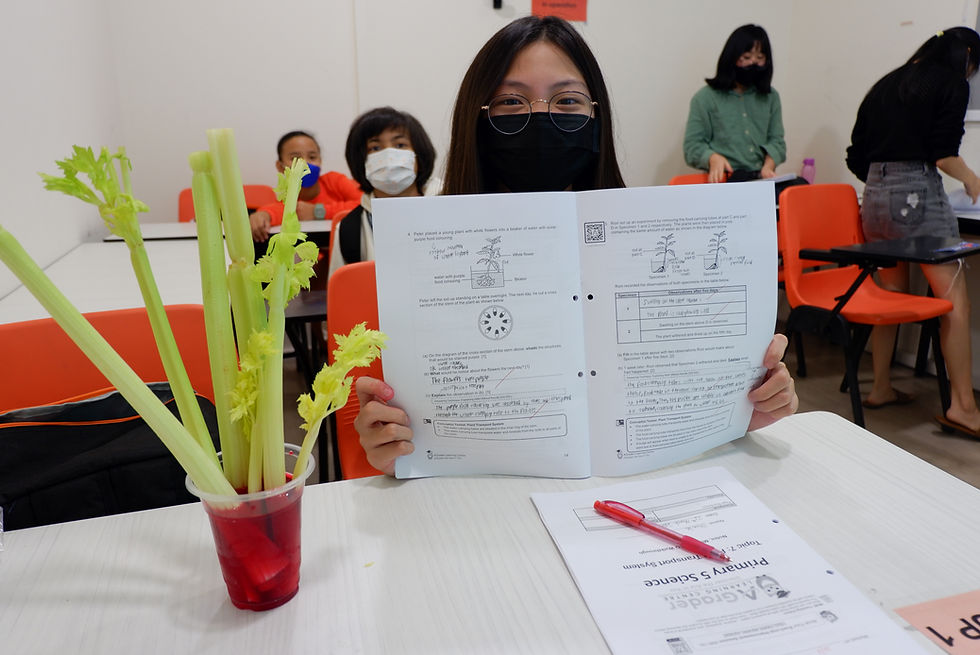Top 3 Must-Know Adaptations for Science PSLE
- AGrader Learning Centre
- Apr 10
- 5 min read

Living organisms must adapt to their environment to survive and thrive. Over millions of years, animals and plants have developed unique adaptations that increase their chances of survival. These adaptations help them regulate water levels, maintain body temperature, find food, and reproduce in their environment. In science PSLE, students must understand how organisms adapt to their environment and how natural selection plays a role in shaping these adaptations.
In this article, we will explore three commonly tested organisms – the camel, the cactus, and the polar bear – and examine their key adaptations. Understanding these examples will help students grasp the concept of adaptation for survival and improve their ability to tackle PSLE science questions effectively.
Table of Contents:
How Do Organisms Adapt to Their Environment?
Organisms adapt to their environment through two main types of adaptations: structural adaptations and behavioural adaptations. Structural adaptations refer to physical features that help living things adapt to their environment, such as body shape, specialised organs, or protective coverings. Behavioural adaptations, on the other hand, are actions that organisms take to survive, such as migration, hibernation, or nocturnal activity.
To illustrate these concepts, let’s examine three fascinating examples of how plants and animals adapt to extreme environments.
1. How Camels Adapt to Hot Desert Conditions
The camel is a well-known example of an animal that has adapted to its environment. Found in some of the hottest and driest places on Earth, camels possess several structural and behavioural adaptations that help them store water, regulate temperature, and survive in harsh desert conditions.

Legend:
S: structural adaptation B: behavioural adaptation
Structural Adaptations:
Hump for Fat Storage: A camel’s hump does not store water but rather fat, which provides energy during long periods without food.
Thick Fur and Skin: Camels have thick fur on their back to shield them from the sun’s heat, while their skin helps reduce water loss.
Long Legs: Their long legs help keep their bodies away from the hot sand, reducing heat absorption.
Wide Feet: Their broad, padded feet prevent them from sinking into the sand.
Long Eyelashes and Covered Nostrils: Help block sand from entering the eyes and nostrils.
Behavioural Adaptations:
Water Conservation: Camels can drink large amounts of water at once and store it in their bloodstream. They can survive without water for long periods by minimising sweat production.
Nasal Adaptations: Their nostrils can close to keep out sand during sandstorms.
Regulating Body Temperature: Camels allow their body temperature to fluctuate throughout the day to reduce sweating and conserve water.
Urinate/sweat very little: Camels urinate and sweat very little, further reducing water loss in hot, dry environments.
2. How Cacti Adapt to Survive in the Desert
Just like camels, cacti have developed unique plant adaptations to thrive in extreme heat and dry conditions. Since plants cannot move to find water, they have evolved features that help them store water and minimise evaporation.

Legend:
S: structural adaptation
Structural Adaptations:
Waxy Coating: Reduces water loss.
Spines or Needle-Like Leaves: Cacti have spines instead of leaves, which reduce water loss and protect the plant from herbivores.
Thick, Waxy Skin: Helps retain moisture by reducing water evaporation.
Shallow but Wide Root System: Allows cacti to quickly absorb rainwater before it evaporates.
Stem for Water Storage: The thick, fleshy stem stores water, enabling the cactus to survive long periods of drought.
Cacti also show some plant behavioural adaptations by opening their stomata (tiny pores on leaves) at night instead of during the day. This adaptation helps them minimise water loss while still taking in carbon dioxide for photosynthesis.
3. How Polar Bears Survive in the Arctic
Polar bears live in one of the coldest environments on Earth, where temperatures can drop to extreme lows. To survive in such conditions, they must reduce heat loss, hunt efficiently, and protect their young.

Structural Adaptations:
Thick White Fur and Fat Layer: A dense fur coat and a thick layer of fat (blubber) provide insulation against the cold and help with camouflage.
Black Skin: A polar bear’s skin is black, which helps it absorb heat from the sun.
Large Webbed Paws: Their large, furry paws help them walk on snow and ice without sinking.
Sharp Claws and Teeth: Polar bears have strong claws and teeth to catch and eat prey, such as seals.
Keen Sense of Smell: Helps detect prey from a great distance.
Stiff Hair on Paws: Increases friction to improve grip.
Strong Limbs and Sharp Claws: Aids in chasing and killing prey.
Small Ears: Reduced surface area to minimise heat loss.
Behavioural Adaptations:
Hunting Techniques: Polar bears are excellent swimmers and use sea ice as platforms to hunt seals.
Hibernation in Dens: Female polar bears dig dens in the snow to give birth and protect their cubs from the cold.
Rolling in Snow: They roll in the snow to clean their fur, which helps maintain insulation.

Why Are Adaptations Important?
Adaptations are crucial for the survival of living organisms. Without the ability to adapt and survive in environmental changes and challenges, species would struggle to find food, reproduce, or protect themselves from predators. Over millions of years, natural selection ensures that only those with the best adaptations continue to survive and thrive.
For instance, plants adapting to their environment ensures they can obtain sufficient sunlight, water, and nutrients. Similarly, animals adapt through behavioural and structural changes that help them cope with extreme temperatures, predators, or food shortages.
Understanding these principles helps students apply their knowledge in science PSLE questions, particularly when explaining how organism adaptation plays a role in ecosystems.
With a strong grasp of adaptation for survival, students will be well-equipped to tackle PSLE science questions with confidence and accuracy. Keep exploring, stay curious, and remember that understanding how animals and plants adapt to their environment is key to excelling in science!
Parents of Primary 6 students preparing for the PSLE should strongly consider enrolling their children in AGrader Learning Centre’s Primary Science programme. Every weekly lesson at AGrader is meticulously planned to align with the latest MOE syllabus, ensuring that students receive the most relevant and updated content. Lessons are taught ahead of school, allowing students to gain a strong foundation and stay ahead of their peers. With high-quality, in-house curated worksheets accompanying each lesson, students develop confidence in tackling Science concepts while sharpening their answering techniques for PSLE-style questions. Whether your child needs support for P3-P5 Science or requires intensive preparation for the PSLE, AGrader’s experienced teachers are dedicated to providing top-tier guidance and ensuring students grasp key concepts effectively.

Beyond the regular weekly lessons, every AGrader student enjoys exclusive access to additional after-class learning resources at no extra cost. Our EverLoop Modules allow students to revise and reinforce concepts as many times as needed, enhancing retention and understanding without the burden of hidden fees. This extra support gives students the edge they need to excel in PSLE Science. Don’t leave your child’s success to chance—enrol in AGrader Learning Centre today and give them the advantage of structured, expert-led learning that makes a difference!
Join Our AGrader Community Today! (Free for all AGrader & Non-AGrader students)
Join our Telegram and WhatsApp channels to gain access to more study tips, free downloads, and much more for all subjects.
- WhatsApp channel: https://bit.ly/agwachannel
- Telegram channel: https://bit.ly/agtelchannel
Feel free to explore more related topics in this section:








Comments